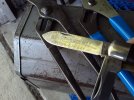chevyrulez1
Gold Member
- Joined
- Oct 2, 2007
- Messages
- 792
I have searched and tried to research this out but am little confused by the lack of info on the old Camillus black plastic handled electricians knives. I have a few examples I have picked up from different sources over the years. Looking at the tang stamp on this particular one it appears it is late 70’s - 80’s manufacture. However, when I look back at the old Camillus product catalogs from that time period the only thing they are showing is the model 27, which has the brown delrin handles. So where did these black handled models come from? Were they made for another company like Excelite or something and the tang stamp is the only marking left? One of the reasons I am asking is that it seems like the blades are stainless, or at least semi-stainless but I can’t tell. They don’t appear to patina like 1095. I see mentioned online that they did start using Stainless at some point but nobody really seems to state when they switched to stainless from carbon steel. There is lots of info out there about the military TL-29’s, but these are not really the same knife. Here are a few pictures, I would appreciate any info or if someone could point me in the right direction on figuring out exactly what blade material this would be


